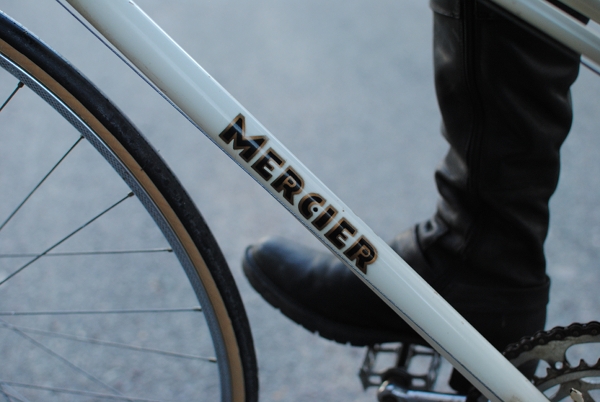
Posting this at the end of April Fool's Day might raise suspicion, but I promise it's true: I have another "new" bike. The Co-Habitant and I were returning home from some errands and minding our own business, not even remotely entertaining the possibility of new bike acquisitions...

...when we saw a striking, if slightly decrepit, cream and black
Mercier mixte outside of a nearby bike store. This was not the typical mixte we tend to see in these parts, so we got curious. After trying the bicycle I was amazed at how wonderfully it rode - despite the slick 20mm tires the bike shop chose to fit it with! The poor, lonely
Mercier was for sale at a very modest sum.

Half an hour later, I was pedaling it home (after paying for it of course), and now the
Mercier is mine!
 Mercier
Mercier was a well-respected French bicycle manufacturer in the 1960s and 70s, competing with
Peugeot,
Motobecane and
Gitane. Mysteriously, almost no information is now available on the original
Mercier (even the wikipedia entry has been deleted). Though a new company now exists under the same brand name, it has no relation to the original manufacturer.
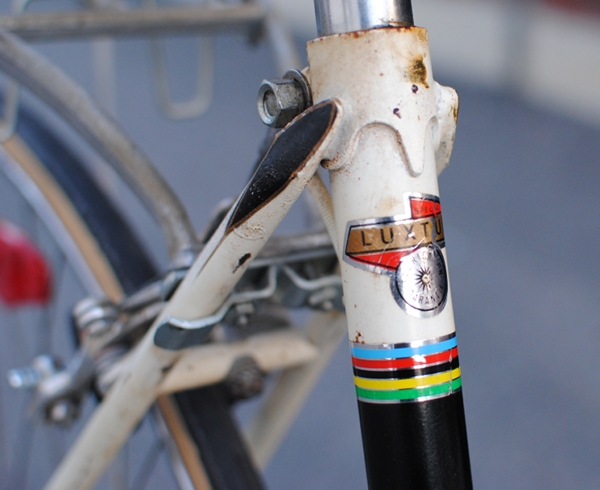
I don't know where to start describing why I like this bicycle and feel that I must have it. For one thing, there is the attractive lugging. Here is the seat cluster with pinstriping detail on the top of the stays.
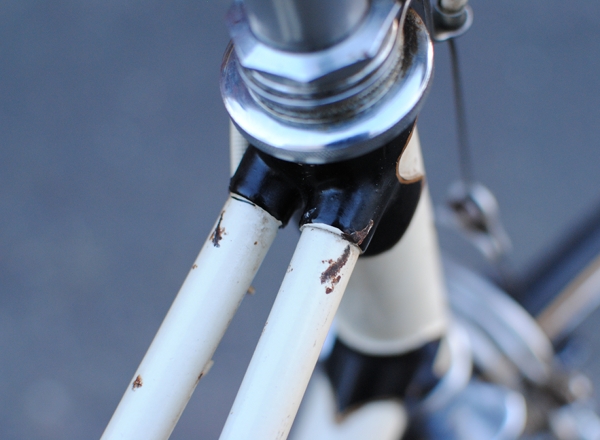
Split headtube lug for the twin lateral stays - something my
Motobecane mixte does not have.
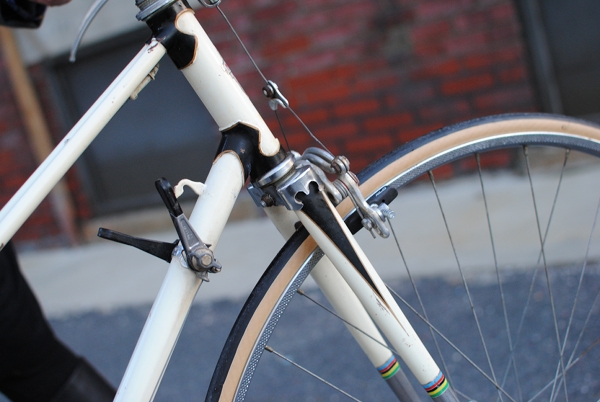
Headtube lugs, fork crown, and pinstriping on the fork. Downtube shifters (which I do not find particularly attractive, but can easily replace). Overall, the lugwork and other aspects of the bicycle's "decor" are charmingly eccentric compared to other mixtes I have seen.
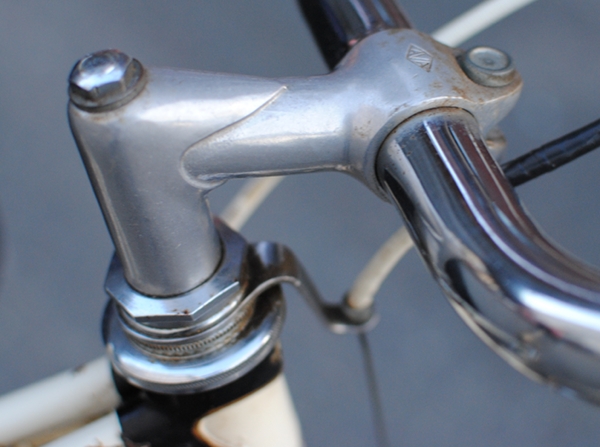
The components seem to be a mixed bag of lower and higher end. The stem, which I find beautiful, is an AVA stem, which Sheldon Brown described as follows:
"Many higher-quality French bicycles of the '70's came with AVA brand bars and stems. These have a reputation for failure, and should be replaced if the bike is to be ridden hard or fast."
Hmmm... "higher quality" and "failure" in the same sentence? Should I interpret this to mean that as long as I don't race on the bike, the AVA stem will be okay? That is how I would like to interpret it. Advice welcome.

The handlebars are a narrow version of North Roads (what I imagine Nitto's "Dove Bars" are like) and seem original. I prefer narrower bars and love how these feel when I ride the
Mercier: they give me a great deal of control and my hands don't seem to grow tired.
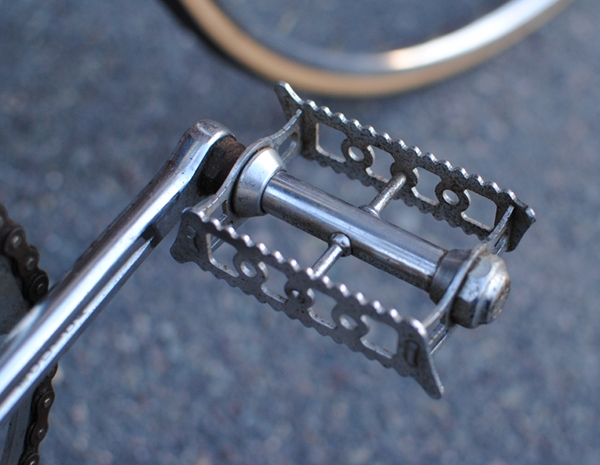
The beautiful
Lyotard pedals feel great.
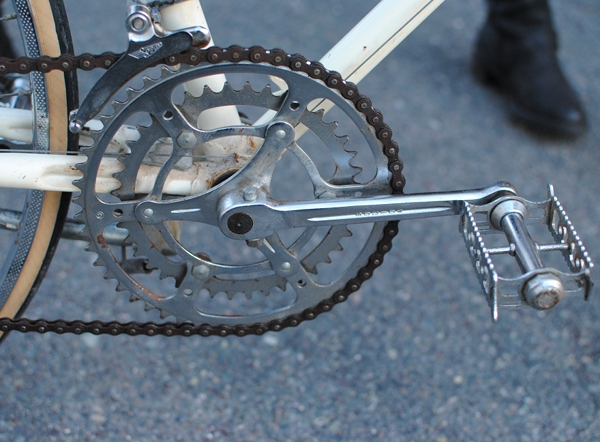 Simplex
Simplex front and rear derailleur, as well as
Simplex dropouts. Classic 10-speed gearing.
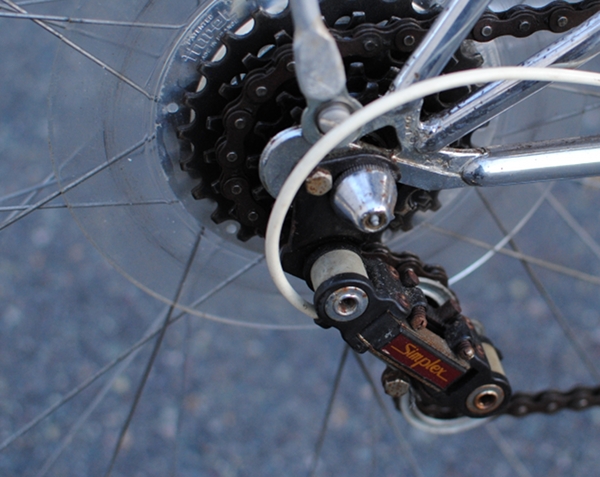
From what I understand, this rear
Simplex derailleur is not good. I am pretty sure it's plastic. The spoke protector ("pie plate") is also original and stamped "made in France".
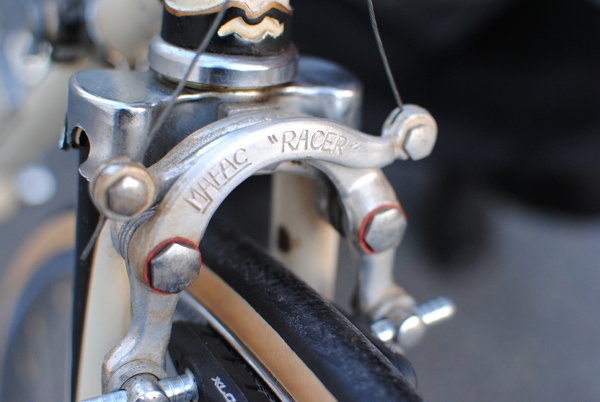
Mafac "Racer" centerpull brakes, which I believe are pretty good. However, the bike has steel rims (bad for braking), so I need to think of a solution to this.
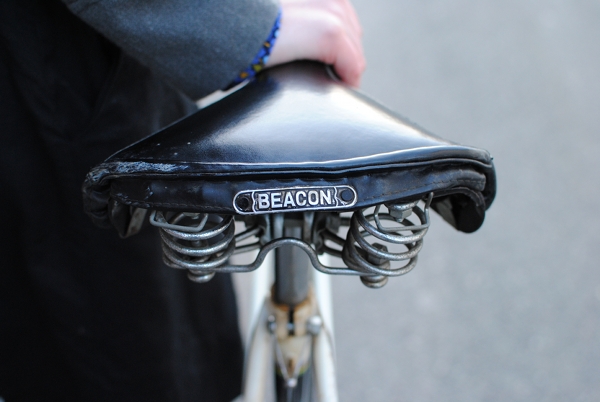
"Beacon" pleather sprung saddle. Feels comfortable so far, but I imagine that after a long ride it will not. I will probably replace it with one of my vintage B72s - but first I want to ride on this one down Beacon Street.

This
Mercier is a 20" frame, whereas my
Motobecane is a 21" frame. This is visible in the heights of their seat tubes, but oddly enough their head tubes and stems are about even - despite the fact that the
Motobecane has a modern, extended
Nitto stem. The Co-Habitant thinks that this is because the
Mercier's virtual top tube is upward-sloping, allowing for the handlebars to be higher in their standard position. Whatever the reason, the
Mercier does not feel like it is too small; it feels just perfect and is extremely comfortable to ride.
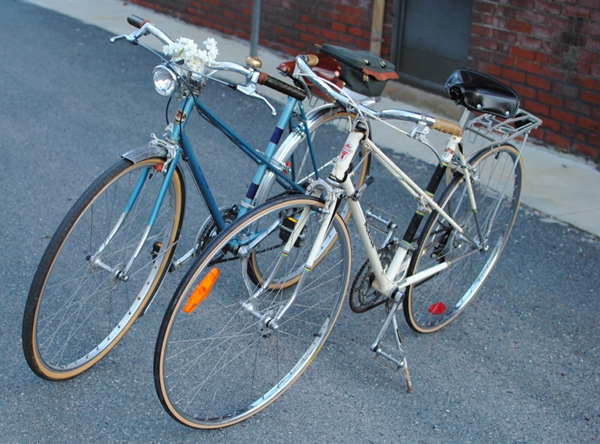
Here is another side by side comparison. Though they are both French mixtes from the 1970s, I find the
Mercier to be a considerably more comfortable ride than the
Motobecane. What elusive aspect of the bikes' geometries and/or components account for this I do not know, but it is so. The
Mercier was a pleasure to ride from the first moment, whereas the
Motobecane required "taming" and is still a bit too "racy" for me even with the many changes I've made in attempts to make it more comfortable for everyday cycling.
So, I am considering doing one of the following:
A. Cannibalizing the better components from the
Motobecane (derailleur, shifters, and - is this possible? - wheels) and building up the
Mercier as my perfect vintage mixte. Then sell off the
Motobecane for cheap.
B. Converting the
Mercier to a single speed, or possibly even fixed gear (you know, to practice for the velodrome). This should be relatively easy and unintrusive, given that it has clamp-on derailleur and shifters, and compatible drop-outs.
Any opinions and advice regarding these options would be much appreciated!

















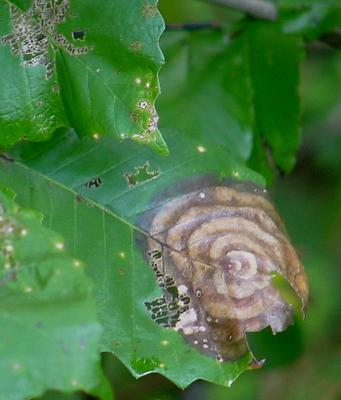




 Posting this at the end of April Fool's Day might raise suspicion, but I promise it's true: I have another "new" bike. The Co-Habitant and I were returning home from some errands and minding our own business, not even remotely entertaining the possibility of new bike acquisitions...
Posting this at the end of April Fool's Day might raise suspicion, but I promise it's true: I have another "new" bike. The Co-Habitant and I were returning home from some errands and minding our own business, not even remotely entertaining the possibility of new bike acquisitions... ...when we saw a striking, if slightly decrepit, cream and black
...when we saw a striking, if slightly decrepit, cream and black  Half an hour later, I was pedaling it home (after paying for it of course), and now the
Half an hour later, I was pedaling it home (after paying for it of course), and now the 
 I don't know where to start describing why I like this bicycle and feel that I must have it. For one thing, there is the attractive lugging. Here is the seat cluster with pinstriping detail on the top of the stays.
I don't know where to start describing why I like this bicycle and feel that I must have it. For one thing, there is the attractive lugging. Here is the seat cluster with pinstriping detail on the top of the stays. Split headtube lug for the twin lateral stays - something my
Split headtube lug for the twin lateral stays - something my  Headtube lugs, fork crown, and pinstriping on the fork. Downtube shifters (which I do not find particularly attractive, but can easily replace). Overall, the lugwork and other aspects of the bicycle's "decor" are charmingly eccentric compared to other mixtes I have seen.
Headtube lugs, fork crown, and pinstriping on the fork. Downtube shifters (which I do not find particularly attractive, but can easily replace). Overall, the lugwork and other aspects of the bicycle's "decor" are charmingly eccentric compared to other mixtes I have seen. The components seem to be a mixed bag of lower and higher end. The stem, which I find beautiful, is an AVA stem, which Sheldon Brown described as follows:
The components seem to be a mixed bag of lower and higher end. The stem, which I find beautiful, is an AVA stem, which Sheldon Brown described as follows: The handlebars are a narrow version of North Roads (what I imagine Nitto's "Dove Bars" are like) and seem original. I prefer narrower bars and love how these feel when I ride the
The handlebars are a narrow version of North Roads (what I imagine Nitto's "Dove Bars" are like) and seem original. I prefer narrower bars and love how these feel when I ride the  The beautiful
The beautiful 
 From what I understand, this rear
From what I understand, this rear  Mafac "Racer" centerpull brakes, which I believe are pretty good. However, the bike has steel rims (bad for braking), so I need to think of a solution to this.
Mafac "Racer" centerpull brakes, which I believe are pretty good. However, the bike has steel rims (bad for braking), so I need to think of a solution to this. "Beacon" pleather sprung saddle. Feels comfortable so far, but I imagine that after a long ride it will not. I will probably replace it with one of my vintage B72s - but first I want to ride on this one down Beacon Street.
"Beacon" pleather sprung saddle. Feels comfortable so far, but I imagine that after a long ride it will not. I will probably replace it with one of my vintage B72s - but first I want to ride on this one down Beacon Street. This
This  Here is another side by side comparison. Though they are both French mixtes from the 1970s, I find the
Here is another side by side comparison. Though they are both French mixtes from the 1970s, I find the 





 They did very well together.
They did very well together. I think they had incredible teamwork together. Especially since it was their first time playing together.
I think they had incredible teamwork together. Especially since it was their first time playing together. The ended up in the championship game and they won their bracket! Woohoo! WTG, Aric!
The ended up in the championship game and they won their bracket! Woohoo! WTG, Aric!
